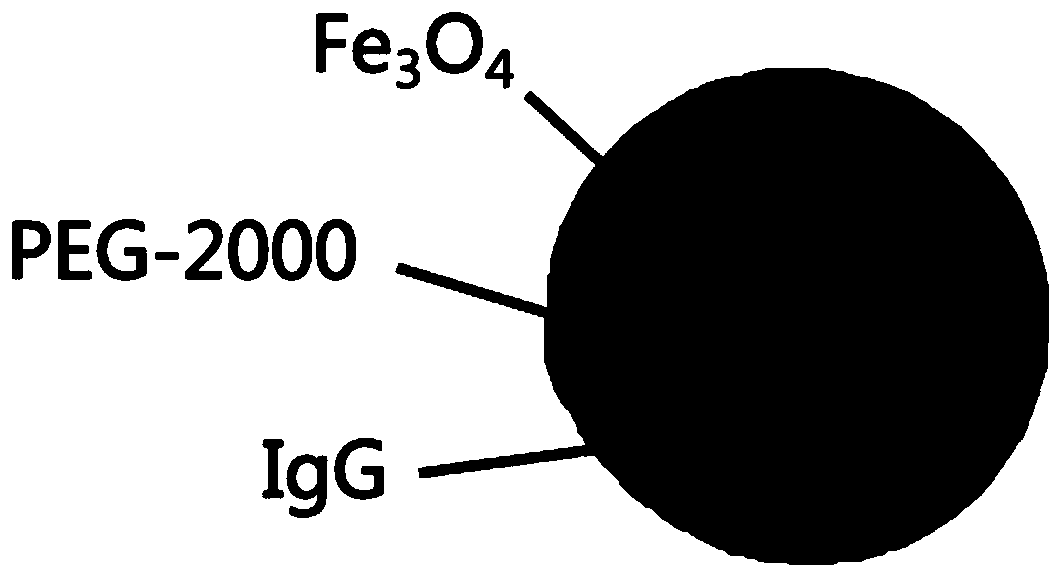Preparation and application for magnetic nanometer microspheres used for magnetic relaxation targeted determination of cancer cells
A magnetic nanometer and cancer cell technology, which can be used in the preparation of in vivo experiments, the determination/inspection of microorganisms, and measurement devices, etc. It can solve the problems of high biological toxicity, accelerated magnetic relaxation measurement, commercial and medical applications, and magnetic saturation strength. Low-level problems, to achieve the effects of low biological toxicity, broad medical application prospects, and high sensitivity
- Summary
- Abstract
- Description
- Claims
- Application Information
AI Technical Summary
Problems solved by technology
Method used
Image
Examples
Embodiment 1
[0034] (1) One-step synthesis method to prepare superparamagnetic Fe 3 o 4 @PEG-COOH nanoparticles
[0035] Dissolve iron acetylacetonate and dicarboxypolyethylene glycol in 2-pyrrolidone. Nitrogen gas is fed into the solution to remove oxygen, and then the reaction is carried out for 60-90 minutes under the conditions of a rotating speed of 300-400 rpm and a temperature of 200-300°C. After the reaction was completed, nitrogen was continuously fed until the solution was cooled to room temperature, and then acetone-ether solution was added to the solution to obtain a black sticky precipitate. The black viscous precipitate was dissolved in deionized water and dialyzed for a period of time to remove the precipitate with molecular weight less than 12000. Then, the precipitate was repeatedly settled by acetone-ether solution and dried in vacuum to obtain superparamagnetic Fe 3 o 4 @PEG-COOH nanoparticles.
[0036] (2) Preparation of Fe by carbodiimide coupling method 3 o 4 ...
Embodiment 2
[0044] The steps of Example 2 of the present invention are the same as Example 1, the difference is that the composition ratio of the substance in the implementation steps is different, specifically as follows:
[0045] In the step (1), the mass ratio of dicarboxypolyethylene glycol to iron acetylacetonate is 5.5:1.
[0046] The dialysis time of the step (1) is 2 days.
[0047] Described step (2) cancer cell antibody, superparamagnetic Fe 3 o 4 The mass ratio of @PEG-COOH nanoparticles, N-hydroxysulfosuccinimide and 1-ethyl-3-[3-dimethylaminopropyl]carbodiimide hydrochloride is 20:4:1 :1
[0048] The volume ratio of acetone and ether in the step (2) acetone-ether solution is 1.3:1.
Embodiment 3
[0050] The steps of Example 3 of the present invention are the same as Example 1, the difference is that the composition ratio of the substance in the implementation steps is different, specifically as follows:
[0051] In the step (1), the mass ratio of dicarboxypolyethylene glycol to iron acetylacetonate is 6:1.
[0052] The dialysis time of the step (1) is 3 days.
[0053] Described step (2) cancer cell antibody, superparamagnetic Fe 3 o 4 The mass ratio of @PEG-COOH nanoparticles, N-hydroxysulfosuccinimide and 1-ethyl-3-[3-dimethylaminopropyl]carbodiimide hydrochloride is 25:6:1 :1
[0054] The volume ratio of acetone and ether in the step (2) acetone-ether solution is 1.5:1.
PUM
 Login to View More
Login to View More Abstract
Description
Claims
Application Information
 Login to View More
Login to View More - R&D
- Intellectual Property
- Life Sciences
- Materials
- Tech Scout
- Unparalleled Data Quality
- Higher Quality Content
- 60% Fewer Hallucinations
Browse by: Latest US Patents, China's latest patents, Technical Efficacy Thesaurus, Application Domain, Technology Topic, Popular Technical Reports.
© 2025 PatSnap. All rights reserved.Legal|Privacy policy|Modern Slavery Act Transparency Statement|Sitemap|About US| Contact US: help@patsnap.com

